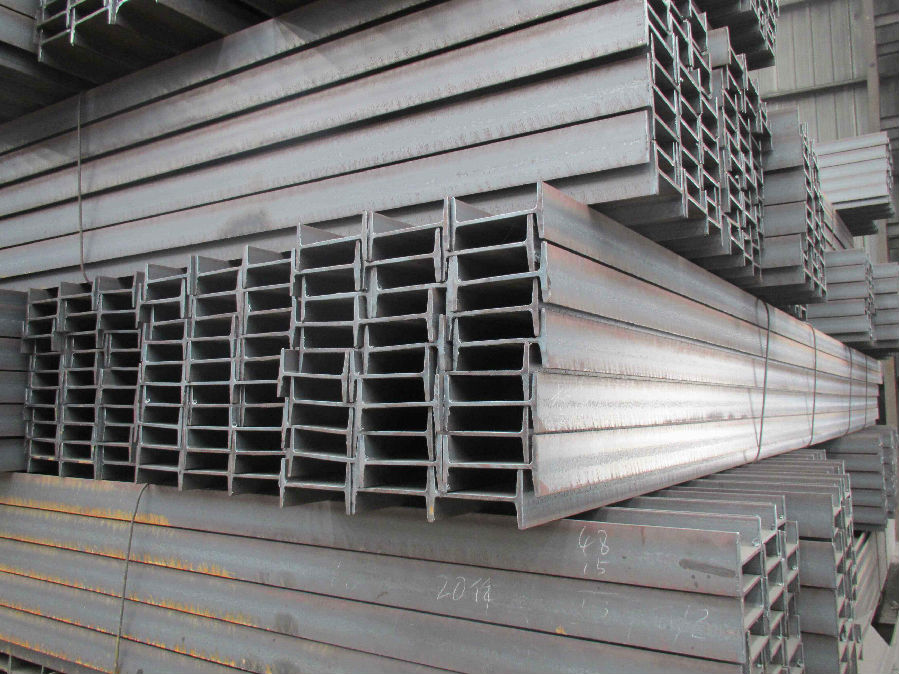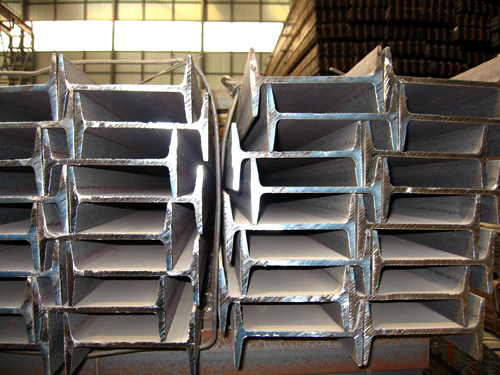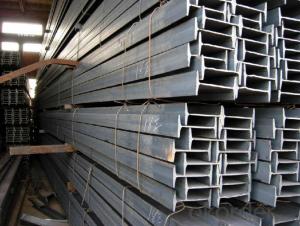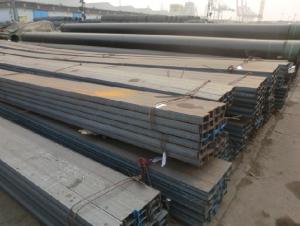Hot Rolled Steel I-Beam For Sale
- Loading Port:
- Qingdao
- Payment Terms:
- TT or LC
- Min Order Qty:
- 3000 PCS
- Supply Capability:
- 40000 PCS/month
OKorder Service Pledge
OKorder Financial Service
You Might Also Like
OKorder is offering high quality Hot Rolled Steel I-Beams at great prices with worldwide shipping. Our supplier is a world-class manufacturer of steel, with our products utilized the world over. OKorder annually supplies products to European, North American and Asian markets. We provide quotations within 24 hours of receiving an inquiry and guarantee competitive prices.
Product Applications:
Hot Rolled Steel I-Beams are ideal for structural applications and are widely used in the construction of buildings and bridges, and the manufacturing, petrochemical, and transportation industries.
Product Advantages:
OKorder's Steel I-Beams are durable, strong, and resist corrosion.
Main Product Features:
· Premium quality
· Prompt delivery & seaworthy packing (30 days after receiving deposit)
· Corrosion resistance
· Can be recycled and reused
· Mill test certification
· Professional Service
· Competitive pricing
Product Specifications:
Manufacture: Hot rolled
Grade: Q195 – 235
Certificates: ISO, SGS, BV, CIQ
Length: 6m – 12m, as per customer request
Packaging: Export packing, nude packing, bundled
Chinese Standard (H*W*T) | Weight (Kg/m) | 6m (pcs/ton) | Light I (H*W*T) | Weight (Kg/m) | 6m (pcs/ton) | Light II (H*W*T) | Weight (Kg/m) | 6M |
100*68*4.5 | 11.261 | 14.8 | 100*66*4.3 | 10.13 | 16.4 | 100*64*4 | 8.45 | 19.7 |
120*74*5.0 | 13.987 | 11.9 | 120*72*4.8 | 12.59 | 13.2 | 120*70*4.5 | 10.49 | 15.8 |
140*80*5.5 | 16.89 | 9.8 | 140*78*5.3 | 15.2 | 10.9 | 140*76*5 | 12.67 | 13.1 |
160*88*6 | 20.513 | 8.1 | 160*86*5.8 | 18.46 | 9 | 160*84*5.5 | 15.38 | 10.8 |
180*94*6.5 | 24.143 | 6.9 | 180*92*6.3 | 21.73 | 7.6 | 180*90*6 | 18.11 | 9.2 |
200*100*7 | 27.929 | 5.9 | 200*98*6.8 | 25.14 | 6.6 | 200*96*6.5 | 20.95 | 7.9 |
220*110*7.5 | 33.07 | 5 | 220*108*7.3 | 29.76 | 5.6 | 220*106*7 | 24.8 | 6.7 |
250*116*8 | 38.105 | 4.3 | 250*114*7.8 | 34.29 | 4.8 | 250*112*7.5 | 28.58 | 5.8 |
280*122*8.5 | 43.492 | 3.8 | 280*120*8.2 | 39.14 | 4.2 | 280*120*8 | 36.97 | 4.5 |
300*126*9 | 48.084 | 3.4 | 300*124*9.2 | 43.28 | 3.8 | 300*124*8.5 | 40.87 | 4 |
320*130*9.5 | 52.717 | 3.1 | 320*127*9.2 | 48.5 | 3.4 | |||
360*136*10 | 60.037 | 2.7 | 360*132*9.5 | 55.23 | 3 |
FAQ:
Q1: Why buy Materials & Equipment from OKorder.com?
A1: All products offered byOKorder.com are carefully selected from China's most reliable manufacturing enterprises. Through its ISO certifications, OKorder.com adheres to the highest standards and a commitment to supply chain safety and customer satisfaction.
Q2: How do we guarantee the quality of our products?
A2: We have established an advanced quality management system which conducts strict quality tests at every step, from raw materials to the final product. At the same time, we provide extensive follow-up service assurances as required.
Q3: How soon can we receive the product after purchase?
A3: Within three days of placing an order, we will begin production. The specific shipping date is dependent upon international and government factors, but is typically 7 to 10 workdays.
Q4: What makes stainless steel stainless?
A4: Stainless steel must contain at least 10.5 % chromium. It is this element that reacts with the oxygen in the air to form a complex chrome-oxide surface layer that is invisible but strong enough to prevent further oxygen from "staining" (rusting) the surface. Higher levels of chromium and the addition of other alloying elements such as nickel and molybdenum enhance this surface layer and improve the corrosion resistance of the stainless material.
Q5: Can stainless steel rust?
A5: Stainless does not "rust" as you think of regular steel rusting with a red oxide on the surface that flakes off. If you see red rust it is probably due to some iron particles that have contaminated the surface of the stainless steel and it is these iron particles that are rusting. Look at the source of the rusting and see if you can remove it from the surface.
Images:


- Q:How do steel I-beams perform in areas with high seismic activity?
- Steel I-beams perform well in areas with high seismic activity due to their structural properties. I-beams are known for their strength, stiffness, and ability to resist lateral forces, making them suitable for seismic zones. The inherent rigidity of steel helps to distribute seismic forces throughout the structure, reducing the risk of collapse during an earthquake. Additionally, steel I-beams can be designed and reinforced to withstand specific seismic loads, ensuring the safety and stability of buildings in such areas.
- Q:How are steel I-beams measured?
- Steel I-beams are typically measured by their height, width, and weight per foot. The height refers to the vertical distance between the top and bottom flanges, while the width represents the horizontal distance between the flanges. The weight per foot indicates the mass of the beam per linear foot. These measurements help determine the structural properties and load-bearing capacity of the I-beam.
- Q:How does the arch concrete of the tunnel be poured up? How can the support be used before the casting? Is it made of I-beam? Is it directly supported by earthwork?
- The excavation of the tunnel face, slag, to the primary support system, first hit the bolt, then use steel or steel made of steel, installation support in tunnel contour, and then sprayed concrete (poor surrounding rock hanging steel mesh, then sprayed fiber concrete).
- Q:Can steel I-beams be used in both residential and commercial construction?
- Steel I-beams are suitable for use in both residential and commercial construction. They are a popular choice in the construction industry due to their strength, durability, and versatility. In residential construction, steel I-beams can be utilized as load-bearing components to support the weight of the structure. This is especially beneficial in the construction of larger homes or multi-story buildings. They are commonly employed to create open floor plans, enabling wider spans and fewer support columns. This allows for greater design flexibility. In commercial construction, steel I-beams are extensively utilized in the construction of large-scale buildings such as office complexes, warehouses, and shopping centers. They provide superior structural integrity, allowing for taller buildings and larger open spaces. Additionally, steel I-beams possess fire-resistant properties, making them a preferred choice for both residential and commercial construction projects due to their safety features. Overall, steel I-beams are a reliable and versatile option for construction projects in both residential and commercial areas.
- Q:How do Steel I-Beams perform in terms of acoustics?
- Steel I-beams have poor acoustic performance due to their rigid and dense nature. They possess high density and low elasticity, which enables them to conduct sound effectively. Consequently, sound waves easily pass through steel I-beams, resulting in inadequate sound insulation. This facilitates considerable sound transmission between rooms or floors, leading to unwanted noise and decreased privacy. Furthermore, steel I-beams can produce a resonance effect, amplifying specific frequencies and causing echoes, reverberation, and an overall unfavorable acoustic environment. Hence, if prioritizing acoustic performance, alternative construction materials or supplementary soundproofing measures should be taken into account.
- Q:Can steel I-beams be used for schools and universities?
- Yes, steel I-beams can be used for schools and universities. Steel I-beams are commonly used in the construction industry due to their strength, durability, and versatility. They have excellent load-bearing capacity, making them suitable for supporting the weight of large structures like schools and universities. Additionally, steel I-beams can be easily fabricated and installed, allowing for efficient construction processes. Moreover, steel is a non-combustible material, which is important for ensuring the safety of the building occupants. Overall, steel I-beams are a popular choice for constructing schools and universities due to their structural integrity, cost-effectiveness, and ability to meet the necessary building codes and regulations.
- Q:What are the common safety considerations when working with steel I-beams?
- Some common safety considerations when working with steel I-beams include proper lifting techniques and equipment, ensuring the beams are securely fastened or braced to prevent movement or collapse, wearing appropriate personal protective equipment (PPE) such as hard hats and steel-toed boots, and adhering to proper weight limits and load distribution guidelines. It is also important to inspect the beams for any defects or damage before use and to follow established procedures for working at heights or in confined spaces.
- Q:Can steel I-beams be used in theaters or auditoriums?
- Yes, steel I-beams can certainly be used in theaters or auditoriums. In fact, they are commonly used in the construction of these types of buildings due to their strength, durability, and versatility. Steel I-beams provide exceptional structural support and can handle heavy loads, making them ideal for large open spaces where a significant amount of weight needs to be supported. Additionally, steel I-beams can be easily fabricated to meet specific design requirements and can be used to create a variety of architectural elements, such as balconies, mezzanines, and catwalks. Their use in theaters and auditoriums ensures the safety and stability of the structure, allowing for a seamless integration of lighting, sound equipment, and other technical components necessary for performances.
- Q:Can steel I-beams be used for telecommunications infrastructure?
- No, steel I-beams are not typically used for telecommunications infrastructure. Telecommunications infrastructure typically requires lighter materials that can support the installation of equipment such as antennas and cables. Steel I-beams are more commonly used in construction for their strength and load-bearing capabilities.
- Q:How do steel I-beams perform in terms of sustainability?
- Steel I-beams are highly sustainable due to their durability, recyclability, and energy efficiency. They have a long lifespan, require minimal maintenance, and can be recycled at the end of their use. Furthermore, steel production processes have become more environmentally friendly, reducing emissions and energy consumption. As a result, steel I-beams are an excellent choice for sustainable construction and infrastructure projects.
1. Manufacturer Overview |
|
|---|---|
| Location | |
| Year Established | |
| Annual Output Value | |
| Main Markets | |
| Company Certifications | |
2. Manufacturer Certificates |
|
|---|---|
| a) Certification Name | |
| Range | |
| Reference | |
| Validity Period | |
3. Manufacturer Capability |
|
|---|---|
| a)Trade Capacity | |
| Nearest Port | |
| Export Percentage | |
| No.of Employees in Trade Department | |
| Language Spoken: | |
| b)Factory Information | |
| Factory Size: | |
| No. of Production Lines | |
| Contract Manufacturing | |
| Product Price Range | |
Send your message to us
Hot Rolled Steel I-Beam For Sale
- Loading Port:
- Qingdao
- Payment Terms:
- TT or LC
- Min Order Qty:
- 3000 PCS
- Supply Capability:
- 40000 PCS/month
OKorder Service Pledge
OKorder Financial Service
Similar products
New products
Hot products
Hot Searches
Related keywords




























